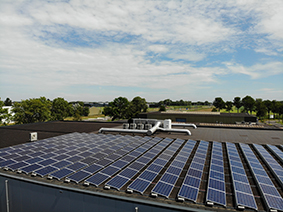Lagosse and sustainable business.
The economy must be sustainable, climate-neutral, circular and inclusive by 2050. Therefore, no company can ignore sustainable business anymore. And this is good news because sustainable business not only delivers environmental and social returns but also financial gains. Lagosse innovates, making the company future-proof and attractive to current and future personnel
How do we put it into practice?
Sustainable business is all about creating social, environmental and economic value. We also call this the 3Ps: people, planet, profit (or prosperity). When you do business sustainably, you try to find a balance between these three aspects. This is not possible without considering sustainability in all business activities and processes. Every decision must consider the impact on the 3Ps. This also means that all stakeholders inside and outside the organisation must take sustainability into account. And being accountable as a company. Sustainable business is a process, not a final destination. Once you move up the sustainability ladder, you can only realise what you are doing wrong’. No company is 100 per cent sustainable. But by working together and being open, we can learn from each other so that we can make strides in sustainability as a company.
Solar panels
Electricity supplier
Consumentenbond, Natuur&Milieu and WISE survey the Dutch energy market every year. The survey determines how sustainable the power from Dutch energy suppliers really is. In the ranking of all energy suppliers the power of our supplier PURE Energie was rated with a 10 for the eighth year in a row! In the survey, energy suppliers are divided into three categories: frontrunners, middle-runners and laggards. Forerunners are actively working on the transition to a sustainable energy supply. Middle runners are still rooted in polluting fossil energy production, but are also investing in sustainability. The laggards do not contribute to a sustainable power supply.
Waste separation
Lagosse’s ambition is to become a pioneer in sustainability. A circular way of handling waste contributes to this. The aim is to reduce the production of waste.
At the UvA, we want to separate waste in another more sustainable way. From September to December, we will test the best approach for this at the university.
Circularity
Circularity, or the reuse of raw materials, is a key principle. The desire is to work with waste partners who turn waste into (raw materials for) new products.
Importance of sorting waste
It is only possible to make new products from waste when the waste is delivered sorted. If the waste is not properly sorted then the waste processor may take the decision not to accept it. The waste then goes to an incineration plant and that is the least sustainable way of waste disposal. No raw materials for new products can then be made from it either
Different ways of separating waste
Method 1
- The current general waste bins will be removed.
- Waste bins for GFT and food waste, coffee cups, paper, plastic packaging and drinking cartons and residual waste.
- This waste will be processed into raw materials and/or new products.
Tip: Did you know, for example, that a receipt does not belong with paper, but with residual waste due to the coating used? And a used paper tissue can be thrown in the organic waste?
Method 2
- Waste bins for so-called ‘wet waste’ and ‘dry waste’. Wet waste consists mainly of waste you can eat and drink or has been in contact with. Dry waste includes other waste.
- Coffee cups are also collected separately and there is a container for paper next to each printer.
- With this method of waste separation, after collection the waste processing company sorts the wet and dry waste into streams that can be well recycled into raw materials and new products.
Method 3
- Waste bins for GFT, food waste and dry waste. Dry waste is literally all waste that is not wet.
- There are also waste bins for paper at printers.
- With this method of waste separation, after collection the waste processing company sorts the wet and dry waste into streams that can be properly recycled into raw materials and new products.



